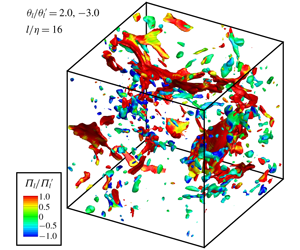Published online by Cambridge University Press: 25 November 2019

The effects of flow topology on the subgrid-scale (SGS) kinetic energy flux in compressible isotropic turbulence is studied. The eight flow topological types based on the three invariants of the filtered velocity gradient tensor are analysed at different scales, along with their roles in the magnitude and direction of kinetic energy transfer. The unstable focus/compressing (UFC), unstable node/saddle/saddle (UN/S/S) and stable focus/stretching (SFS), are the three predominant topological types at all scales; they account for at least 75 % of the flow domain. The UN/S/S and SFS types make major contributions to the average SGS flux of the kinetic energy from large scales to small scales in the inertial range. The unstable focus/stretching (UFS) topology makes a contribution to the reverse SGS flux of kinetic energy from small scales to large scales. In strong compression regions, the average contribution of the stable node/saddle/saddle (SN/S/S) topology to the SGS kinetic energy flux is positive and is predominant over those of other flow topologies. In strong expansion regions, the UFS topology makes a major contribution to the reverse SGS flux of the kinetic energy. As the turbulent Mach number increases, the increase of volume fraction of the UFS topological regions leads to the increase of the SGS backscatter of kinetic energy. The SN/S/S topology makes a dominant contribution to the direct SGS flux of the compressible component of the kinetic energy, while the UFS topology makes a dominant contribution to the reverse SGS flux of the compressible component of the kinetic energy.
To send this article to your Kindle, first ensure no-reply@cambridge.org is added to your Approved Personal Document E-mail List under your Personal Document Settings on the Manage Your Content and Devices page of your Amazon account. Then enter the ‘name’ part of your Kindle email address below. Find out more about sending to your Kindle. Find out more about saving to your Kindle.
Note you can select to save to either the @free.kindle.com or @kindle.com variations. ‘@free.kindle.com’ emails are free but can only be saved to your device when it is connected to wi-fi. ‘@kindle.com’ emails can be delivered even when you are not connected to wi-fi, but note that service fees apply.
Find out more about the Kindle Personal Document Service.
To save this article to your Dropbox account, please select one or more formats and confirm that you agree to abide by our usage policies. If this is the first time you used this feature, you will be asked to authorise Cambridge Core to connect with your Dropbox account. Find out more about saving content to Dropbox.
To save this article to your Google Drive account, please select one or more formats and confirm that you agree to abide by our usage policies. If this is the first time you used this feature, you will be asked to authorise Cambridge Core to connect with your Google Drive account. Find out more about saving content to Google Drive.